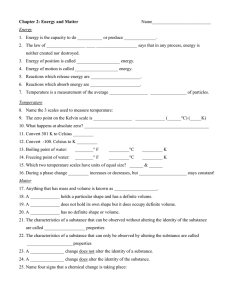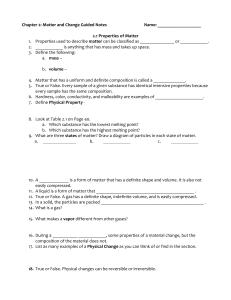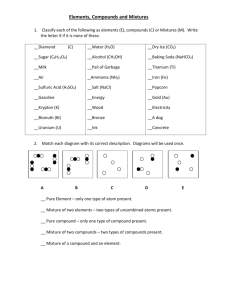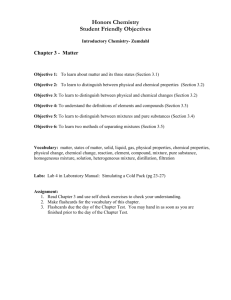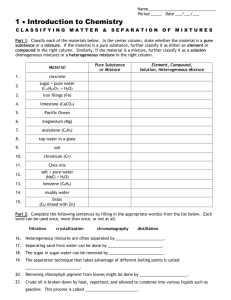Notes: Matter
advertisement
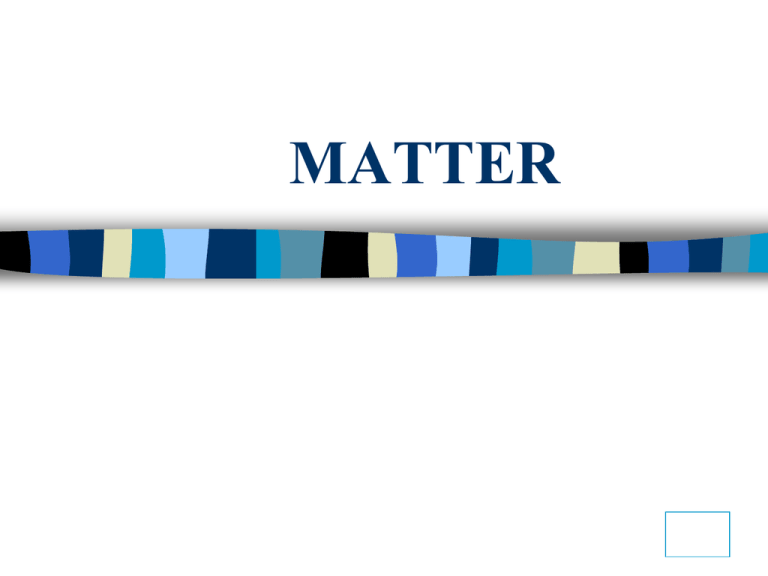
MATTER What is Matter? Matter is anything that has mass and volume. There are 3 States of Matter: Across the top of your notes write…… 1. SOLID 2. LIQUID 3. GAS SOLIDS –hold their shape –have definite volume –particles are very ordered –usually have high density LIQUIDS –occupies a definite volume –no fixed shape –takes the shape of its container –usually have lower densities than solids GASES –have no definite shape –have no definite volume –expand to fill container –usually have densities lower than both solids and liquids What is the 4th state of matter? – It is the most common in the universe – What properties do you think it possess? PROPERTIES OF MATTER Physical Properties characteristics of a substance that can be observed without altering the identity of the substance. Ex: density, color, melting point Chemical Properties characteristics of a substance that cannot be observed without altering the substance. Ex: flammability (ability to burn in air) Physical Changes - a change that does not alter the chemical make-up of the substance. Ex: changing from a pure substance to a mixture Ex: Crushing, tearing, change in state Chemical Change - a change that alters the chemical make-up of a substance. Ex: changing from an element to a compound Ex: burning wood, cooking food. To identify a chemical change look for observable signs: color change bubbling and fizzing light production smoke presence of heat Write in your notes: P for physical change C for chemical change 1. ____ A piece of wood burns to form ash. 2. ____ Water evaporates into steam. 3. ____ A piece of cork is cut in half. 4. ____ A bicycle chain rusts. 5. ____ Food is digested in the stomach. 6. ____ Water is absorbed by a paper towel. 7. ____ Hydrochloric Acid reacts with zinc. P for physical change C for chemical change 8. ____ A piece of an apple rots on the ground. 9. ____ A tire is inflated with air. 10. ____ A plant turns sunlight, CO2, and water into sugar and oxygen. 11. ____ Sugar dissolves in water. 12. ____ You cut your hair. 13. ____ Milk sours. 14. ____ A popsicle melts. 15. ____ Making a peanut, pretzel and cereal mixture. P for physical change C for chemical change 16. ____ Diamonds are used to scratch glass 17. ____ Baking soda reacts with vinegar and forms a gas 18. ____ A piece of metal is bent in half 19. ____ Methanol is burned and leaves a residue 20. ____ An aspirin is crushed into fine powder 21. ____ Copper turns green when exposed to the environment 22. ____ Two clear liquids are mixed and a yellow color forms 23. ____ Baking cookies Conservation of Matter Law of Conservation of Matter: matter is neither created nor destroyed Is the law of conservation of matter conserved in: – Physical change? – Chemical change? Two Categories of Matter 1. Mixtures Mixture - a blend of two or more pure substances. Each substance keeps its own physical and chemical properties Ex: seawater, milk, air 1. Homogeneous - mixture that is uniform throughout. Another name for a homogeneous mixture is a solution. Ex: pure air, soda, pancakes, Kool-Aid Types of Mixtures: 2. Heterogeneous - mixture that is not uniform throughout . Does not blend smoothly Ex: sand, chocolate chip cookies, tacos, fruit salad Ways to separate mixtures….. Filtration- separate a solid and a liquid. Distillation- liquid from a liquid. Crystallization- Solid particles from a dissolved solution. Sublimation- two solids, when 1 sublimes and 1 does not. Chromatography- gas and gas, or liquid and liquid Or you can just pick things out. 2. Pure Substances Have their own set of chemical and physical properties. Uniform and unchanging composition Are any elements or compounds Elements and Compounds Element - a substance that cannot be separated into simpler substances by a chemical change. Particle is the ATOM. Elements To make elements easier to use, we have symbols for each element. Symbols consist of 1 or 2 letters, first one capitalized and the second one lower case. Examples and Symbols Hydrogen H Oxygen O Sodium Na Potassium K Mercury Hg Copper Cu Aluminum Al Helium He Compounds Are formed when two or more different elements combine in a chemical reaction. Most matter in the UNIVERSE is in the form of compounds Particle is the MOLECULE Examples and Formulas Water Rust H2O Fe3O2 Carbon Dioxide Sugar CO2 C6H12O6 Table Salt NaCl

